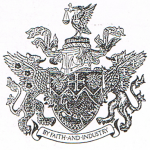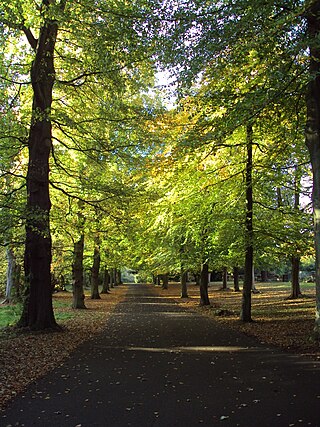
Kirkby is a town in the Metropolitan Borough of Knowsley, Merseyside, England. The town, historically in Lancashire, has a size of 4,070 acres (16.5 km2) is 5 miles (8 km) north of Huyton and 6 miles (10 km) north-east of Liverpool. The population in 2016 was 41,495 making it the largest in Knowsley and the 9th biggest settlement in Merseyside.

The Metropolitan Borough of Knowsley is a metropolitan borough in Merseyside, North West England. It covers several towns and villages, including Kirkby, Prescot, Huyton, Whiston, Halewood, Cronton and Stockbridge Village; Kirkby, Huyton, and Prescot being the major commercial centres. It takes its name from the village of Knowsley, though its headquarters are in Huyton. It forms part of the wider Liverpool City Region.

Halewood is a town and civil parish in the Metropolitan Borough of Knowsley in Merseyside, England. It lies near the city of Liverpool's southeastern boundary, bordered by the suburbs of Netherley, Hunt's Cross and Woolton.

Huyton is a town in the Metropolitan Borough of Knowsley, Merseyside, England. Part of the Liverpool Built-up Area, it borders the Liverpool suburbs of Dovecot, Knotty Ash and Netherley.

West Derby is a suburb of Liverpool, England. It is located east of the city and is also a Liverpool City Council ward. At the 2011 Census, the population was 14,382.

Knotty Ash is an area of Liverpool, Merseyside, England, and a Liverpool City Council Ward. Historically in Lancashire, the population at the 2001 Census was 13,200, increasing to 13,312 at the 2011 Census. Knotty Ash is well known as the home of comedian Sir Ken Dodd, who often mentioned it in his act.

Whiston is a town and civil parish within the Metropolitan Borough of Knowsley in Merseyside, England. Previously recorded within the historic county of Lancashire, it is located eight miles east of Liverpool. The population was 13,629 at the 2001 Census, increasing to 14,263 at the 2011 Census.

Belle Vale is a district of south-east Liverpool, Merseyside, England and a Liverpool City Council Ward that covers both Belle Vale and Netherley.

Knowsley, commonly known as Knowsley Village, is a large village and civil parish located on the north-east outskirts of Liverpool, within the much larger Metropolitan Borough of Knowsley, Merseyside, England. It gave its name to the wider borough when it was formed in 1974.
Grade I, Grade II* and notable Grade IIlisted buildings in the metropolitan boroughs of Knowsley, Liverpool, Sefton, St Helens and Wirral in Merseyside.
Huyton College also known as Liverpool College for Girls, Huyton was an independent day and boarding school for girls founded in England in 1894 as the sister school to Liverpool College with which it merged on 27 July 1993, a few months short of its 100th birthday. The Liverpool College for Girls, Huyton, as it was originally known, was started in 1894 and intended to be parallel to the Liverpool College Boys School. It catered for girls between the ages of 4 and 18. In its early days, and towards the end of its time based at Huyton Hall before the merger, it also took day boys up to the age of seven. The school is mentioned in the book The Wildcats of St Trinian's by Frank Launder.

Knowsley Council, or Knowsley Metropolitan Borough Council, is the local authority of the Metropolitan Borough of Knowsley in Merseyside, England. It is a metropolitan borough council and provides the majority of local government services in the borough. The council has been a member of the Liverpool City Region Combined Authority since 2014.

Tarbock is a village and former civil parish within the Metropolitan Borough of Knowsley, in Merseyside, England. It is situated to the south east of Huyton and to the east of Netherley. The village itself is 6 miles (9.7 km) from Liverpool city centre, 3.5 miles (5.6 km) from Widnes and 2 miles (3.2 km) from Prescot. The M62 motorway junction 6 is in the area and is more familiarly called Tarbock Island. At the 2001 Census, the population of Tarbock was 2,382. The parish council was abolished on 1 April 2014.

Robertson Gladstone, was an English merchant and politician. He was the second son, and third child of Sir John Gladstone and the brother of William Ewart Gladstone who was Prime Minister of the United Kingdom four times. Robertson was a successful merchant, businessman, property developer and local politician. One of the youngest men elected Mayor of Liverpool, he was religious but increasingly tolerant of nonconformity, emphasised by a move towards semi-socialist politics.

Knowsley United was an English football club based in what is now the Metropolitan Borough of Knowsley in Merseyside from 1963 to 1997. Founded in Kirkby as Kirkby Town, the club moved to Huyton in 1988 and took the name Knowsley United.
Court Hey Hall was a mansion in England built for Robertson Gladstone (1805–1875), elder brother of William Gladstone.
Huyton with Roby is a district in the Metropolitan Borough of Knowsley, Merseyside, England. Formerly the civil parish of Hyton-with-Roby, it contains the settlements of Huyton and Roby. The district contains 26 buildings that are recorded in the National Heritage List for England as designated listed buildings. Of these, one is listed at Grade II*, the middle of the three grades, and the others are at Grade II, the lowest grade.

Arrowe Country Park is a country park in Arrowe Park, Wirral, England, adjacent to the Woodchurch housing estate. The estate upon which the park lies was founded and shaped by John Shaw, a former Mayor of Liverpool who made his wealth from the slave trade. When he died the estate passed to his great nephew John "Ralph" Shaw, who built Arrowe Hall, an Elizabethan-style mansion, and laid out the grounds and gardens. Ralph Shaw was a magistrate who dissuaded people from trespassing on his land with traps including spring-loaded shotguns.

The National Wildflower Centre opened in the Knowsley borough of Merseyside, England, in 2000 as a Millennium project, funded by the Millennium Commission and Big Lottery. It closed at this location in January 2017 and the Eden Project stepped in to save its legacy and build a new partnership from its new southwest base. Originally located in Court Hey Park, Liverpool, the visitor attraction was hoped to regenerate and help communities in the local area. The centre was designed around the concept of Wildflowers. This was combined with a visitor centre, a shop and a cafe.
















